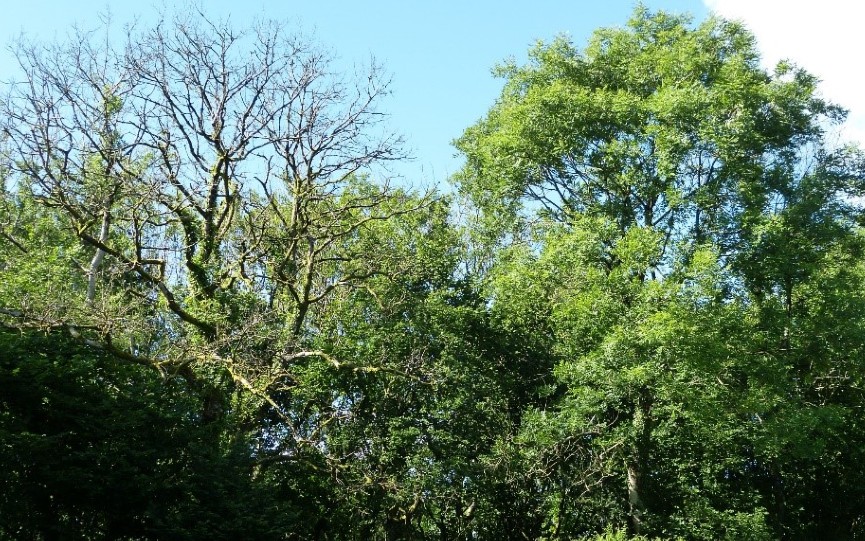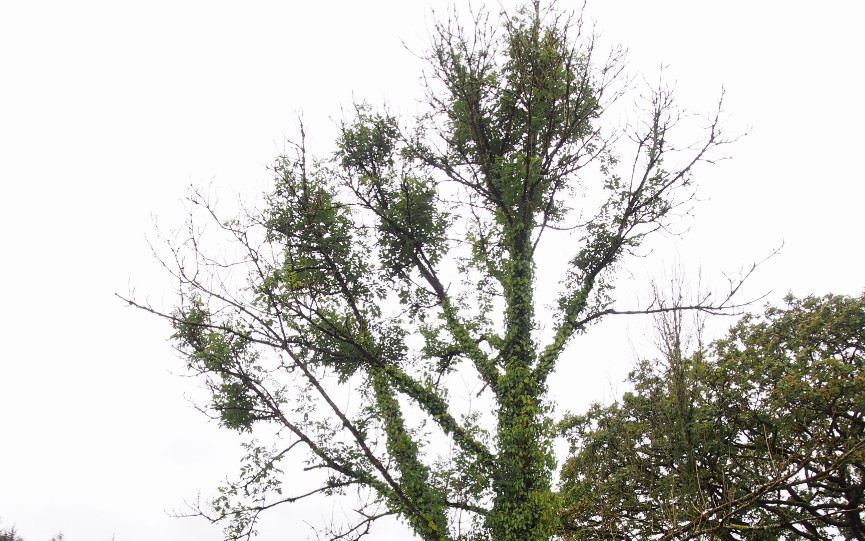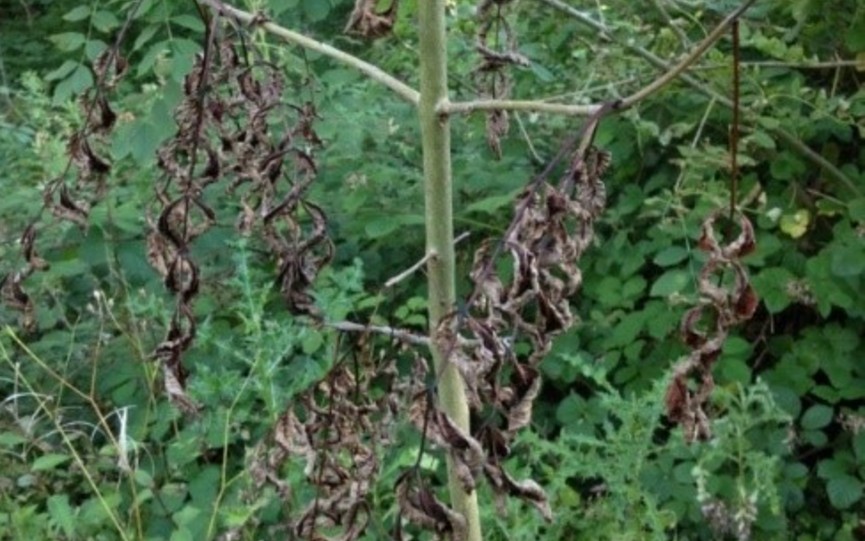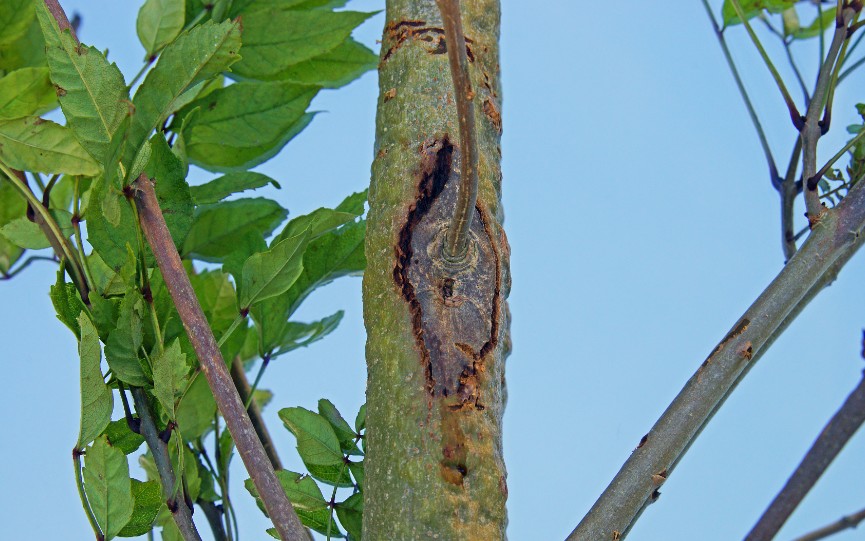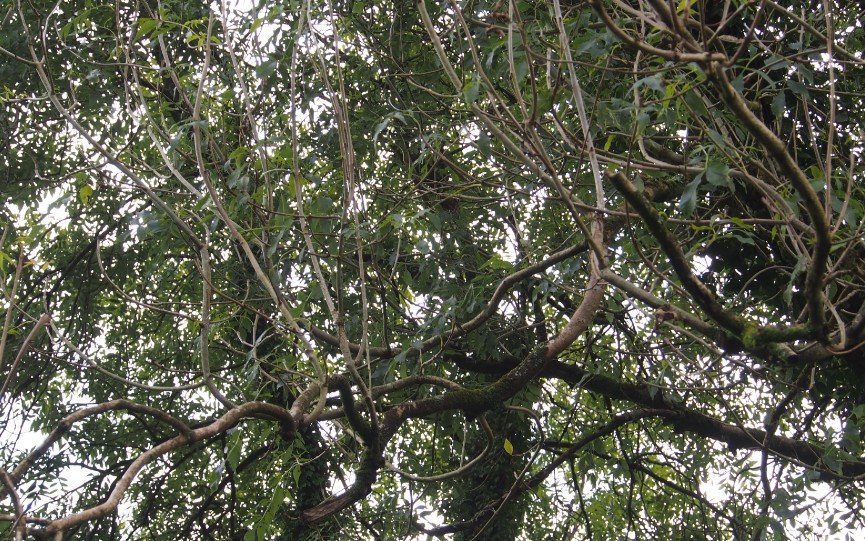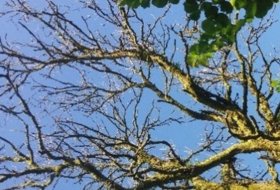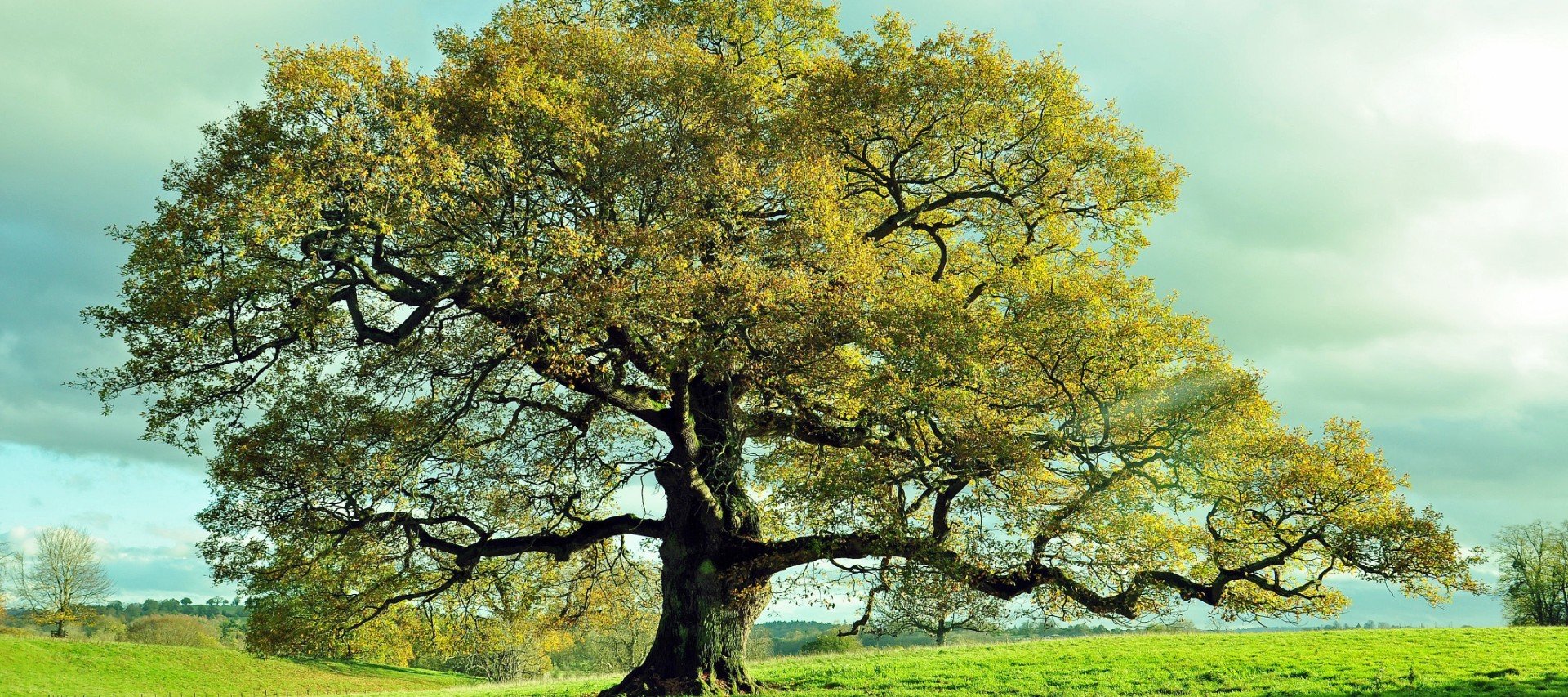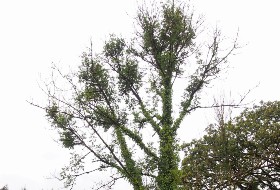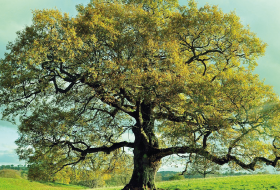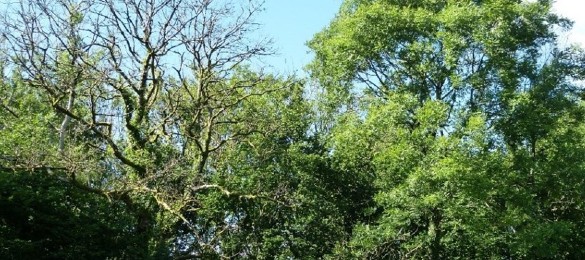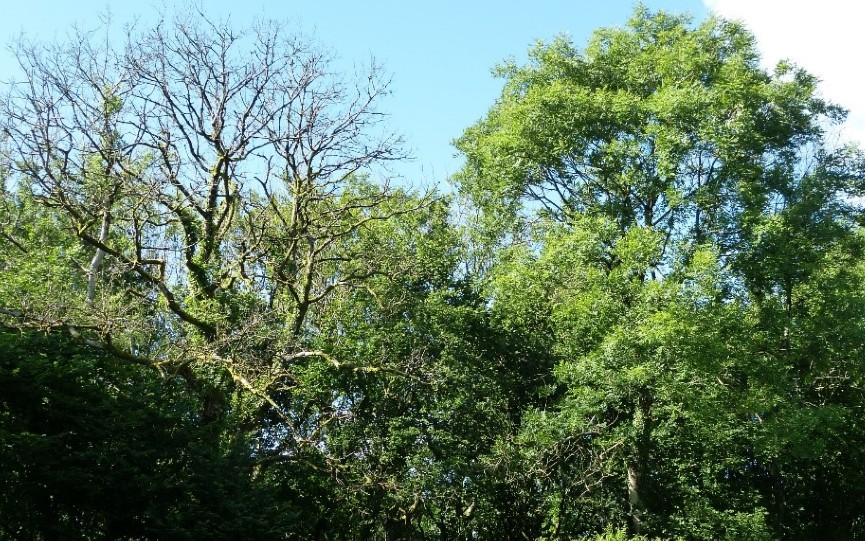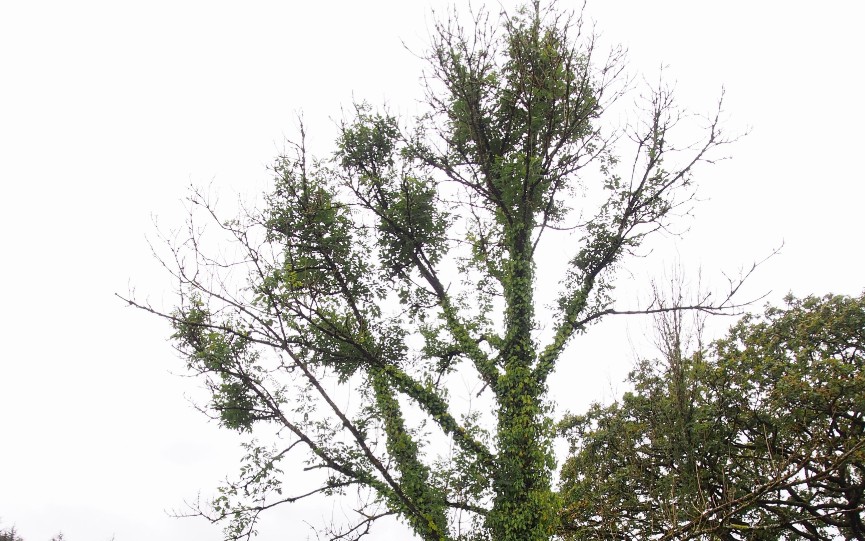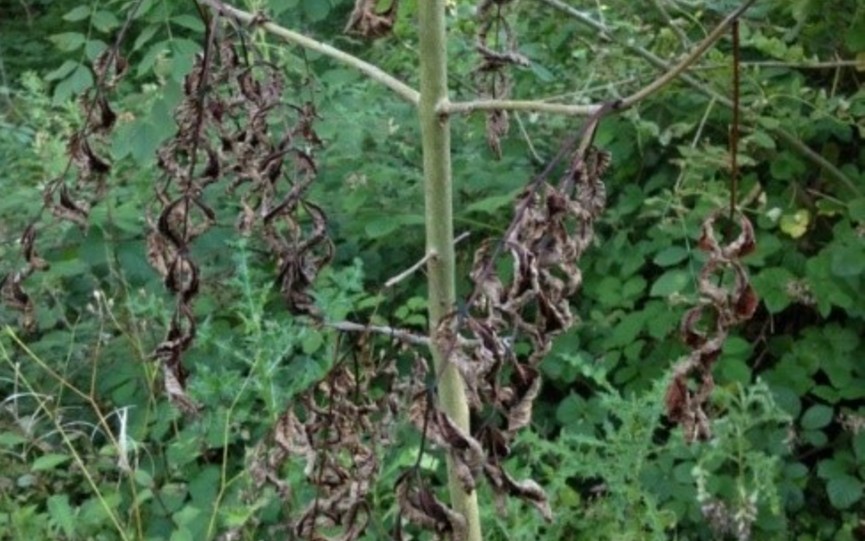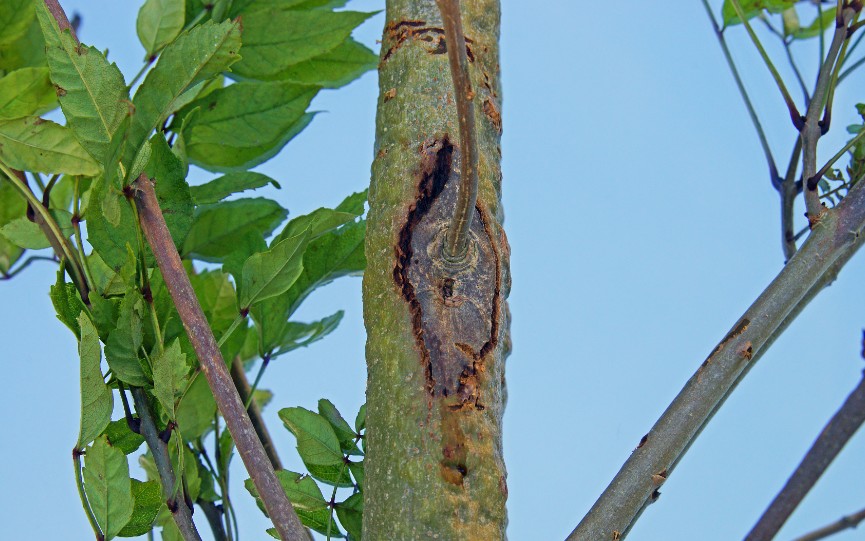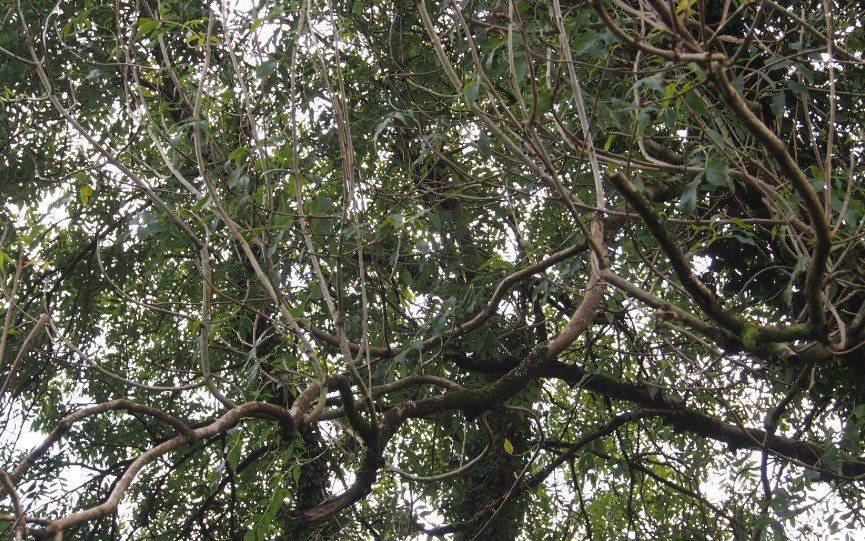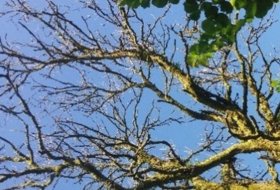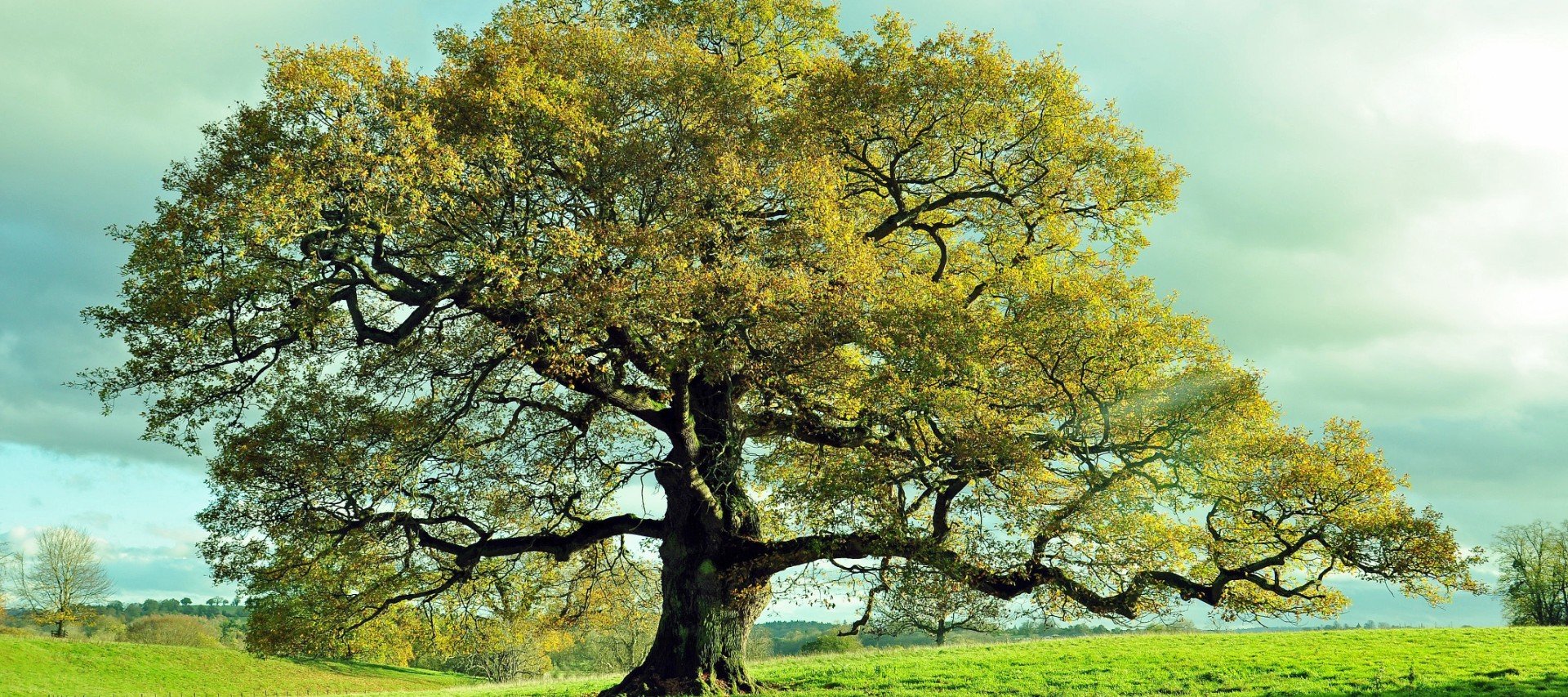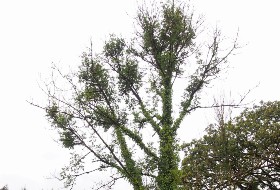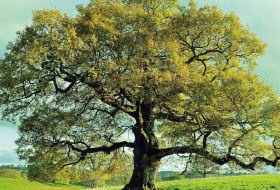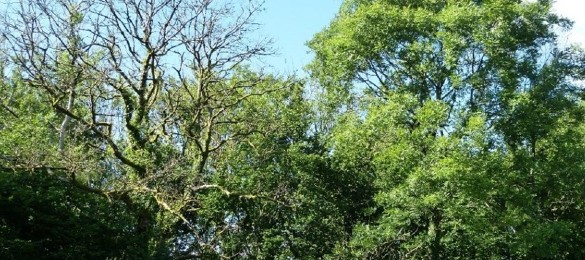Ash dieback disease
Page updated on: 04/12/2023
Ash dieback is a fungal disease which is affecting all species of ash trees across Carmarthenshire, as well as the rest of the country.
A Europe-wide problem, the fungus attaches itself to the leaves of ash trees and spreads through to the branches, causing the tree to die. Dead branches and entire dead trees can become very brittle and fall, posing a serious risk to the public.
Symptoms of the disease are usually first apparent in the crown of the tree, with leaves turning black and falling in late summer rather than autumn, there can also be visible lesions above and below the point where the branches join the trunk of the tree.
Ash dieback is a serious issue for councils and landowners across the UK; it is estimated 90% of ash trees could die of this disease with currently no known treatment.
What are we doing?
- We are making sure tree safety surveys on our land are up-to-date and that any necessary works are carried out.
- Surveys to specifically identify ash dieback are being undertaken along the highway, starting with A and B roads. Trees showing at least 50% of ash dieback disease are being tagged with orange ribbon or marked with orange spray paint for follow-up action.
- A campaign is being launched to raise awareness, particularly in relation to landowners’ responsibilities.
- There will be a need for new tree planting to compensate for the loss of ash trees and we will be seeking funding to support re-planting projects.
Ash dieback is a fungal disease that is affecting ash trees across the UK and Europe. It is thought to have arrived in the UK around 20 years ago from fungal spores carried by wind from the continent and from infected tree planting stock imported from mainland Europe. The fungus (known as Chlalara or Hymenoscyphus fraxineus) is thought to have originated in Asia where it co-exists with native ash species there but has caused widespread damage across mainland Europe where up to 90% of ash trees have been killed by the disease in some areas.
Ash dieback affects the leaves of ash trees causing them to blacken, wilt and die from around June onwards. For very young trees this and the diamond shaped legions (areas of discoloured bark) on the stem are the key features of early infection. As the name suggests, the disease causes the tree to die back from the edge of its canopy. In mature trees, the first sign of the disease is bare, dead twigs at the top of the tree and ends of the branches. As the disease progresses and the number and length of dead branches increases, the tree responds by growing new leaves closer to the main branches and trunk giving the tree a clumpy ‘pom-pom’ look. Eventually the tree will look increasingly bare and dead. Ash dieback can also lead to serious discolouration, cracking and death of the bark at the base of the trunk. Ash trees with these symptoms have a higher risk of sudden death and collapse, so should be a priority for safety works if in a location which poses a risk to public safety.
Seek the advice of a tree specialist accredited with The Arboricultural Association, the professional association that sets the standards for tree surgery. You can find a directory of consultants and contractors on The Arboricultural Association website.
Ash dieback is widespread across much of Wales but, possibly because of the climate, the infection rate is particularly high in Carmarthenshire. The exact percentage of ash trees affected by the disease is not known but it is clear that the majority of ash trees in the county will be affected by the disease in the next few years with many of these dying or seriously declining.
Once infected, there is no evidence to suggest that individual trees can recover from the disease. Some trees may survive for a number of years but, once infected it is unlikely that a tree will survive for more than 10 years. However, the speed of decline of a tree with ash dieback can vary, with some trees deteriorating to a dangerous condition within a couple of years. Forest Research is carrying out work to identify resistant strains of ash trees that could be used to breed new planting stock in the future, but the availability of resistant ash trees for planting is likely to be some years off.
Ash dieback only affects ash tree (Fraxinus spp) including common ash (Fraxinus excelsior) and other species of ash that may be found in the UK, for example, narrow-leaved ash (Fraxinus angustifolia). Other tree species are not known to be affected by ash dieback.
It is important to clean your shoes before and after visiting a woodland and to wash your car or bike wheels to remove mud or plant matter. You should avoid taking cuttings or plant material from the countryside.
A lot of work is underway. Funding is in place to employ an ash dieback project officer and a high number of officers have been trained to recognise the disease. In line with other local authorities across England and Wales, the approach we are adopting to manage ash dieback is that set out by The Tree Council in its Ash Dieback Action Plan.
We are making sure tree safety surveys carried out on our own land such as schools, parks, car parks and housing areas are up-to-date and that any necessary works are carried out. Surveys to specifically identify ash dieback are being undertaken along the highway, starting with A and B roads, as well frequently used Safe Routes to School. Trees showing at least 50% of ash dieback disease are being tagged with orange ribbon or marked with orange spray paint for follow-up action. We will be liaising with landowners with diseased trees on land adjacent to public areas, in particular the public highway, to ensure appropriate action is taken.
A communications campaign is being launched to raise awareness of the disease with residents, to educate landowners of their responsibilities in relation to public safety; as well as to promote the need for new tree planting to compensate for the loss of ash trees in Carmarthenshire.
If you are concerned that an ash tree on public land, for example, next to the highway or in a park, car park or housing area, has ash dieback disease, please report it using our online form. Due to the scale of the disease, we are following a risk-based approach in dealing with infected ash trees, focusing our resources initially on areas of high use. As a result, all reports from members of the public will be logged and investigated in line with our ash dieback policy. Ash trees affected by ash dieback in other public areas should be reported to the relevant public body.
Under the Occupiers’ Liability Act 1957 and 1984 and the Health and Safety at Work Act 1974 landowners have a legal requirement to ensure that trees on their land are maintained to a safe standard and do not pose a risk to the public (note that this includes all trees and not just ash trees). If a tree with obvious defects causes damage to people or property when it falls, or its branches fall, it is highly likely that the landowner could be legally liable for such damage. It is important that landowners take appropriate action to assess the risk posed by all trees on their land, including trees on boundaries, in poor condition. The risk presented by a tree in poor health or with dead or dying branches depends on its location as well as its condition. Trees in poor condition close to areas of high use (for example, main roads) will pose a much higher risk than trees in fields, hedgerows and woodlands away from houses and public rights of way. Remember that trees provide valuable wildlife benefits and should not be felled unless they present a risk to public safety. If in doubt consult a qualified arborist. It is advised you use tree surgeons that are accredited by The Arboricultural Association as these contractors work to the highest safety and professional standards. Always check that your contractor has valid public liability insurance.
Trees next to the public highway are usually the responsibility of the owner of the land adjoining the highway. However, under the Highways Act 1980, we have a legal duty to make sure the highways are maintained to a safe standard; and as a result, we can make formal requests to landowners to remove or cut back trees which are a risk to the public. Trees on main roads with a high level of usage which have lost 50% or more of their canopy or which are showing other signs of failure at the base of the trunk (for example, other fungal infections or cavities) should be removed as a precautionary measure if within falling distance of the highway, due to the risk posed and potential fast rate of decline of some ash trees. Healthy trees should be monitored annually to check for infection.
Due to the large number of trees along our highways that are showing symptoms of the disease, if our survey indicates that an ash tree is showing at least 50% of ash dieback, an informal letter will be sent to the landowner advising them that the tree should be felled. If felling is not carried out within a year, a formal letter will be issued. Where a tree has crown dieback exceeding 75%, or where it poses a more immediate risk, the formal four stage legal process under the Highways Act will be initiated.
If you need to fell trees that could potentially fall on to or across the highway or cause any other danger to highway users then you must employ a qualified traffic management contractor. They will set up a temporary traffic management system to ensure that the safety of motorists and pedestrians is managed appropriately during the tree safety works. Landowners can be held liable and can be prosecuted for any injury caused to the public as a result of any works they have instructed / carried out.
If a road closure is required to carry out the works, landowners will need to apply to our highways section for a road closure which can be done online. A well-qualified and experienced tree surgeon will be able to advise of the necessary arrangements that you will need to make with regard to highways safety.
If you fail to remove a diseased tree which is a risk to public safety, we can ultimately enter your land to carry out the necessary works and claim back the costs. This would only be done if you have failed to act on our advice, following the four-stage legal process under the Highways Act.
Diseased trees close to high-use areas or areas used by vulnerable people (for example, schools and playgrounds) should be a priority for survey and safety work, however, all trees within falling distance of public areas should be assessed for the risk they pose. In general, the lower the level of public usage, the lower the risk. However, ash tree which have lost 75% or more of its canopy or which are showing signs of ash dieback at the base of the trunk and are within falling distance of moderate use areas should be removed as a precautionary measure. Healthy trees and those with lower levels of dieback should be monitored annually.
Landowners’ duty of care extends to trees that have the potential to cause damage to private property as well as members of the public. If you have an ash tree within falling distance of your neighbour’s property you have a responsibility to ensure that these trees do not pose a risk. Healthy trees and those with lower levels of ash dieback should also be monitored annually.
If you are concerned about ash trees on your neighbour’s property the best action is to discuss this with your neighbour, highlighting the potential risks posed by ash dieback and, if necessary, the legal responsibilities imposed on all landowners by the Occupiers’ Liability Act 1957 and 1984. If in doubt consult a qualified arborist accredited by The Arboricultural Association.
If you wish to carry out works to a tree which is the subject of a TPO you will need to apply for consent; and you will need to give notice before carrying out any work on trees which are in a conservation area. You can apply online for consent to carry out works on trees under a TPO or in a conservation area.
If for some unexpected reason the health of the tree becomes an emergency and felling is essential on grounds of safety, take photos of the tree to support your decision-making, and once you have felled the tree contact the arboricultural officer as soon as you reasonably can, for example, the next working day. Please email STEdwards@carmarthenshrie.gov.uk or call 01267 228689.
Natural Resource Wales (NRW) is responsible for administering felling licences and the Forestry Act (1967) sets out the legislation associated with tree felling. Trees in gardens, churchyards and public open spaces are exempt from this legislation.
Felling diseased ash trees requires a felling licence from the Forestry Commission, unless the trees are dead or pose a real and immediate danger. Full guidance on the management of individual ash trees affected by ash dieback can be found on the Forestry Commission website.
NRW may investigate incidents of tree felling where a felling licence has not been issued and will take enforcement action where there is no obvious exception available. You are advised to contact NRW to discuss whether you will need a felling licence before carrying out the works.
If a tree is posing a high safety risk, that is, it is within falling distance of a busy road or junction, then the tree should be felled as soon as possible in order to remove the risk. However, where the ash dieback is only affecting up to 50% of the canopy of the tree, and there is time to plan its removal, felling may be easiest after all the leaves have fallen in the late autumn or winter. This is also a better time of year in terms of the impact of the felling on wildlife. Always aim to avoid the bird nesting season (roughly late February to early August). Birds will nest not only amongst the branches but also in cavities, and it is an offence under the Wildlife and Countryside Act (1981) to destroy a bird, its nest or its eggs.
There are no restrictions on the movement of the timber. If the timber is unaffected larger sections can be planked and used for joinery and wood-turning; or small branches can be left for wildlife habitat. Affected timber is darker and very brittle and is suitable for firewood.
There is little guidance on biosecurity. If you are managing a site that is particularly important to you, for example a park or perhaps your garden, you may want to rake up and remove / burn the ash leaves that fall beneath your ash trees. This will destroy any of the fungal spores that are found on the leaves. This is obviously impractical in a woodland setting. Do not compost these leaves as composting may not kill the spores.
Mature ash trees with holes and crevices may well support bats and nesting birds and possibly dormice, all of which are protected by law. While emergency felling may be necessary in some cases, it may take a year or more for an infected tree to become dangerous, so felling can be planned for the autumn and winter months which would help to reduce any negative impact on wildlife. Avoid felling during the bird nesting season, approximately late February to early August. Emergency felling of trees that contain cracks and crevices and might support bats should make use of ‘soft felling techniques’, that is, leaving the felled sections on the ground for 48 hours after felling to enable bats and other wildlife to leave the timber. There may also be other options to felling the entire tree, for example, it may be possible to retain the trunk, and this could be of great value to wildlife. Felling ash trees in habitats that support dormice is best undertaken during the winter between November and February to limit the effects on dormice. Woodland, scrub, hedgerows and bramble provide suitable habitats. Sites where large amounts of ash trees are to be felled should be discussed with NRW’s species licensing team.
Unfortunately, there are no grants currently available for dealing with ash dieback disease. We will update this page if there is any change.
We run a free woodland advisory service through our Coed Cymru project. Please contact our Coed Cymru officer for further information; email GHellier@carmarthenshire.gov.uk or phone 01558 825303. You will also find advice on the Woodland Trust and The Tree Council websites.
We usually advise that in the countryside you plant species that are native or already common in the landscape. In gardens and more formal landscapes you may want to introduce a new ornamental species. Only purchase trees that have been grown in the UK, ideally in Wales.
Trees for the wider countryside:
- Sessile or pedunculate oak
- Small leaved lime, not currently common but now considered appropriate for planting in Carmarthenshire
- Beech
- Aspen
- Scot’s pine
Trees for large gardens and bigger spaces:
- Plane tree
- Tulip tree
- Norway maple
- Lime – small leave or other varieties
- Scot’s pine
- Oak
- Hornbeam
- Beech
- Sweet chestnut
- Holly
Trees for smaller spaces:
- Silver or Downy birch
- Aspen – but it can sucker
- Crab apple
- Rowan
- Whitebeam
- Field Maple
- Holly
If you need to fell trees that could potentially fall on to or across the Public Right of Way or cause any other danger to Rights of Way users, then you must contact the Countryside Access Team, e-mail prow@carmarthenshire.gov.uk or phone 01554 742216.
If necessary, they will issue an Emergency Closure Notice to prevent public access for a maximum of six weeks while the work is being carried out. Landowners can be held liable and can be prosecuted for any injury caused to the public as a result of any works they have instructed / carried out. A well-qualified and experienced tree surgeon will be able to advise you of the necessary arrangements that you will need to make regarding public safety.
Planning
Planning Application Guide
- Development Idea
- Do I need a Planning Agent?
- Key Information
- Pre-Application Stage
- Types of Planning Application
- Application submission
- Validation
- Live Application
- Planning Committee
- Appeals
- Compliance / Enforcement
- Completion of Development
Major Planning Applications
Extending / changing your home
- Lawful Development Certificate
- Pre-application advice service
- Householder planning permission
- Neighbouring properties / party walls
- Bats and nesting birds
- Conservation areas
- Listed buildings
Search for a Planning Application
Breach of planning
Change of Use (Planning)
Pre-application consultation (PAC)
Highways planning liaison
Development Viability Model (DVM) Assessment Tool
Sustainable Drainage Systems (SuDS)
Apply for Section 106 funds
Local Development Order (LDO)
Listed Buildings and Conservation Areas
- Understanding listing
- When is listed building consent required?
- Alterations to Listed Buildings
- Applying for listed building consent
- What happens after a decision on listed building consent has been made?
- Works to a listed building without consent
- Maintenance and Repair
- Further sources of information
- Conservation Areas
Conservation & countryside
Street naming and numbering
My Nearest - Planning information
Planning Policy
- Local Development Plan 2006 - 2021
- LDP Review Report
- Supplementary Planning Guidance (SPG)
- Affordable Housing
- Affordable Housing areas
- Annual Monitoring Report (AMR)
- Housing Land Supply
- Community Infrastructure Levy (CIL)
Local Development Plan 2018 - 2033
- Integrated Sustainability Appraisal and Habitats Regulations Assessment
- Delivery Agreement
- Candidate Sites
- Inspector’s Report and Adoption
- Submission and Independent Examination
- Second Deposit Revised Local Development Plan
- Preferred Strategy (Pre-Deposit Public Consultation)
- Development of an evidence base
- Frequently asked questions
- First Deposit Revised LDP
Renewable Energy
Planning Ecology
New phosphates targets
- What action have we taken?
- West Wales Calculator
- Mitigation Measures
- Next Steps
- Phosphates - Frequently Asked Questions
- Teifi Demonstrator Catchment Project
Biodiversity
- Why biodiversity matters?
- Priority Species in Carmarthenshire
- Priority Habitats in Carmarthenshire
- Carmarthenshire Nature Partnership
- HLF Bogs project
- Marsh fritillary project
- Hedgerows
- Woodlands
- Pollinators
- Get out and about!
- Legislation and Guidance
- Protected sites
- Ash dieback disease
- Wildlife in your Ward
- Local Places for Nature
Waste
More from Planning


